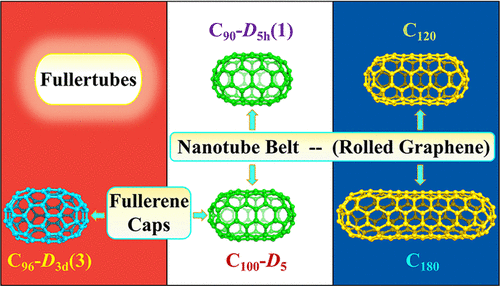当前位置:
X-MOL 学术
›
J. Am. Chem. Soc.
›
论文详情
Our official English website, www.x-mol.net, welcomes your
feedback! (Note: you will need to create a separate account there.)
Fullertubes: Cylindrical Carbon with Half-Fullerene Endcaps and Tubular Graphene Belts, their Chemical Enrichment, Crystallography of Pristine C90-D5h(1) and C100-D5d(1) Fullertubes, and Isolation of C108, C120, C132, and C156 Cages of Unknown Structures
Journal of the American Chemical Society ( IF 14.4 ) Pub Date : 2020-08-23 , DOI: 10.1021/jacs.0c08529
Ryan M Koenig 1 , Han-Rui Tian 2 , Tiffany L Seeler 1 , Katelyn R Tepper 1 , Hannah M Franklin 1 , Zuo-Chang Chen 2 , Su-Yuan Xie 2 , Steven Stevenson 1
Journal of the American Chemical Society ( IF 14.4 ) Pub Date : 2020-08-23 , DOI: 10.1021/jacs.0c08529
Ryan M Koenig 1 , Han-Rui Tian 2 , Tiffany L Seeler 1 , Katelyn R Tepper 1 , Hannah M Franklin 1 , Zuo-Chang Chen 2 , Su-Yuan Xie 2 , Steven Stevenson 1
Affiliation

|
We report a chemical separation method to isolate fullertubes - a new and soluble allotrope of carbon whose structure merges nanotube, graphene, and fullerene subunits. Fullertubes possess single-walled carbon nanotube belts resembling a rolled graphene midsection, but with half-fullerene endcaps. Unlike nanotubes, fullertubes are reproducible in structure, possess a defined molecular weight, and are soluble in pristine form. The high reactivity of amines with spheroidal fullerene cages enables their removal and allows a facile isolation of C96-D3d(3), C90-D5h(1), and C100-D5d(1) fullertubes. A non-chromatographic step (Stage 1) uses a selective reaction of carbon cages with aminopropanol to permit a highly enriched sample of fullertubes. Spheroidal fullerenes are reacted and removed by attaching water-soluble groups onto their cage surfaces. With this enriched (100-1000 times) fullertube mixture, Stage 2 becomes a simple HPLC collection with a single column. This two-stage separation approach permits fullertubes in scalable quantities. Characterization of purified C100-D5d(1) fullertubes is done with samples isolated in pristine and unfunctionalized form. Surprisingly, C60 and C100-D5d(1) are both purplish in solution. For X-ray crystallographic analysis, we used decapyrrylcorannulene (DPC). Isomerically purified C90 and C100 fullertubes were mixed with DPC to obtain black cocrystals of 2DPC{C90-D5h(1)}·4(toluene) and 2DPC{C100-D5d(1)}·4(toluene), respectively. A serendipitous outcome of this chemical separation approach is the enrichment and purification of several unreported larger carbon species, e.g., C120, C132, and C156. Isolation of these higher cage species represents a significant advance in the unknown experimental arena of C100-C200 structures. Our findings represent seminal experimental evidence for the existence of two mathematically predicted families of fullertubes - one family with an axial hexagon, with the other series based on an axial pentagon ring. Fullertubes have been predicted theoretically, and herein is their experimental evidence, isolation, and initial characterization.
中文翻译:

富勒管:具有半富勒烯封端和管状石墨烯带的圆柱形碳、它们的化学富集、原始 C90-D5h(1) 和 C100-D5d(1) 富勒管的晶体学,以及 C108、C120、C132 和 C156 笼的分离结构
我们报告了一种分离富勒管的化学分离方法 - 一种新的可溶碳同素异形体,其结构融合了纳米管、石墨烯和富勒烯亚基。富勒管具有类似于卷状石墨烯中间部分的单壁碳纳米管带,但具有半富勒烯端盖。与纳米管不同,富勒管在结构上是可重现的,具有确定的分子量,并且可以以原始形式溶解。胺与球状富勒烯笼的高反应性使其能够被移除,并允许轻松隔离 C96-D3d(3)、C90-D5h(1) 和 C100-D5d(1) 富勒管。非色谱步骤(第 1 阶段)使用碳笼与氨基丙醇的选择性反应来获得高度富集的富勒管样品。球状富勒烯通过将水溶性基团连接到其笼表面上而发生反应并去除。使用这种富集的(100-1000 倍)富勒管混合物,第 2 阶段变成了一个简单的 HPLC 收集,只有一个柱子。这种两级分离方法允许可扩展数量的富勒管。纯化的 C100-D5d(1) 富勒管的表征是通过以原始和非功能化形式分离的样品完成的。令人惊讶的是,C60 和 C100-D5d(1) 在溶液中都呈紫色。对于 X 射线晶体学分析,我们使用了十吡咯环烯 (DPC)。将异构纯化的 C90 和 C100 富勒管与 DPC 混合,分别获得 2DPC{C90-D5h(1)}·4(甲苯)和 2DPC{C100-D5d(1)}·4(甲苯)的黑色共晶。这种化学分离方法的一个意外结果是富集和纯化了几种未报告的较大碳物种,例如 C120、C132 和 C156。这些较高笼物种的分离代表了 C100-C200 结构未知实验领域的重大进步。我们的发现代表了存在两个数学预测的富勒管系列的开创性实验证据 - 一个系列具有轴向六边形,另一个系列基于轴向五边形环。富勒管已在理论上被预测,这里是它们的实验证据、隔离和初始表征。
更新日期:2020-08-23
中文翻译:

富勒管:具有半富勒烯封端和管状石墨烯带的圆柱形碳、它们的化学富集、原始 C90-D5h(1) 和 C100-D5d(1) 富勒管的晶体学,以及 C108、C120、C132 和 C156 笼的分离结构
我们报告了一种分离富勒管的化学分离方法 - 一种新的可溶碳同素异形体,其结构融合了纳米管、石墨烯和富勒烯亚基。富勒管具有类似于卷状石墨烯中间部分的单壁碳纳米管带,但具有半富勒烯端盖。与纳米管不同,富勒管在结构上是可重现的,具有确定的分子量,并且可以以原始形式溶解。胺与球状富勒烯笼的高反应性使其能够被移除,并允许轻松隔离 C96-D3d(3)、C90-D5h(1) 和 C100-D5d(1) 富勒管。非色谱步骤(第 1 阶段)使用碳笼与氨基丙醇的选择性反应来获得高度富集的富勒管样品。球状富勒烯通过将水溶性基团连接到其笼表面上而发生反应并去除。使用这种富集的(100-1000 倍)富勒管混合物,第 2 阶段变成了一个简单的 HPLC 收集,只有一个柱子。这种两级分离方法允许可扩展数量的富勒管。纯化的 C100-D5d(1) 富勒管的表征是通过以原始和非功能化形式分离的样品完成的。令人惊讶的是,C60 和 C100-D5d(1) 在溶液中都呈紫色。对于 X 射线晶体学分析,我们使用了十吡咯环烯 (DPC)。将异构纯化的 C90 和 C100 富勒管与 DPC 混合,分别获得 2DPC{C90-D5h(1)}·4(甲苯)和 2DPC{C100-D5d(1)}·4(甲苯)的黑色共晶。这种化学分离方法的一个意外结果是富集和纯化了几种未报告的较大碳物种,例如 C120、C132 和 C156。这些较高笼物种的分离代表了 C100-C200 结构未知实验领域的重大进步。我们的发现代表了存在两个数学预测的富勒管系列的开创性实验证据 - 一个系列具有轴向六边形,另一个系列基于轴向五边形环。富勒管已在理论上被预测,这里是它们的实验证据、隔离和初始表征。

































 京公网安备 11010802027423号
京公网安备 11010802027423号